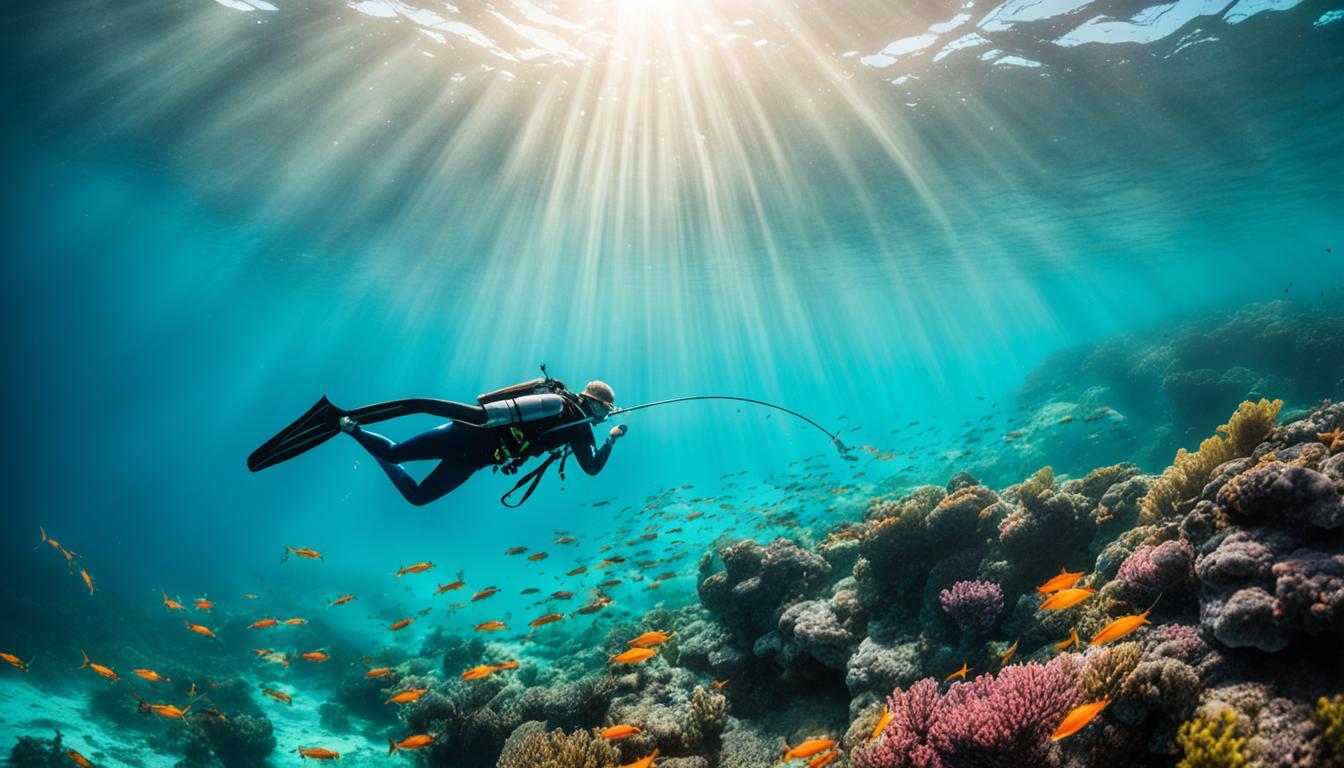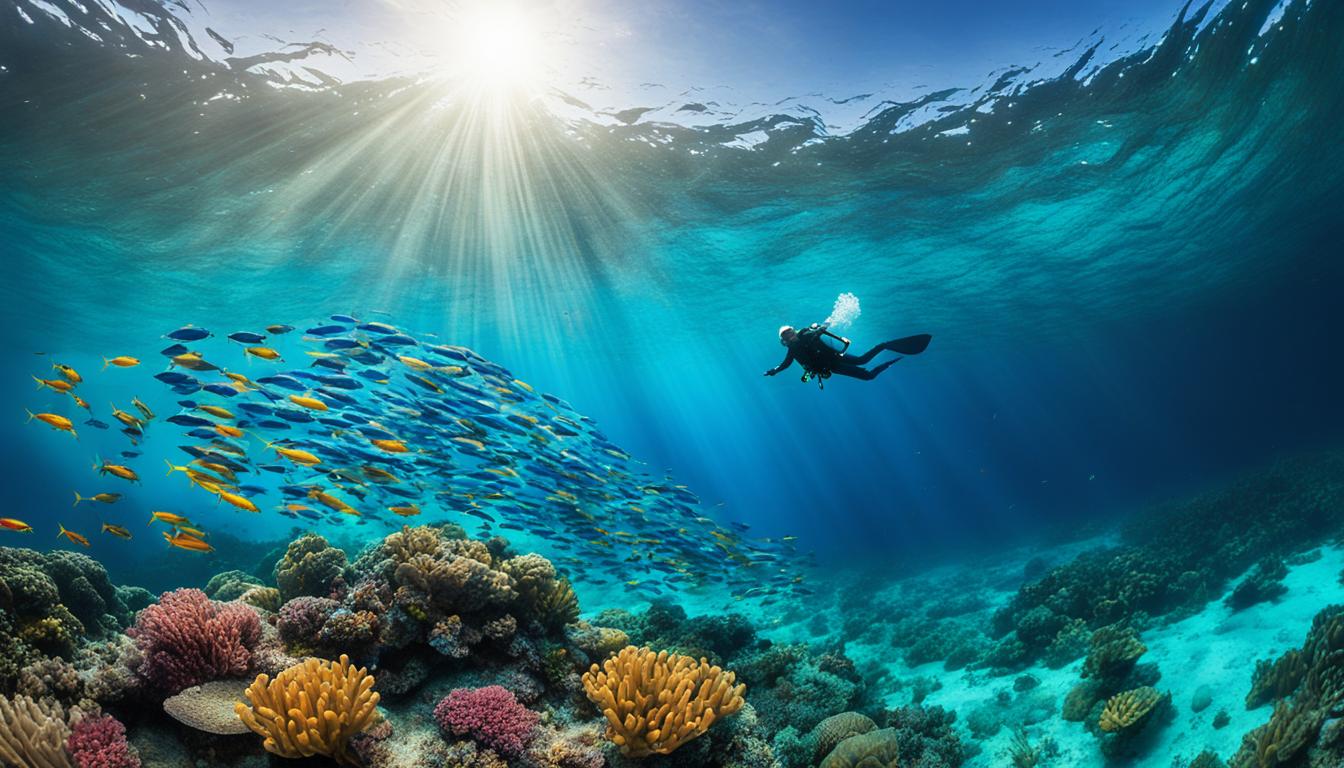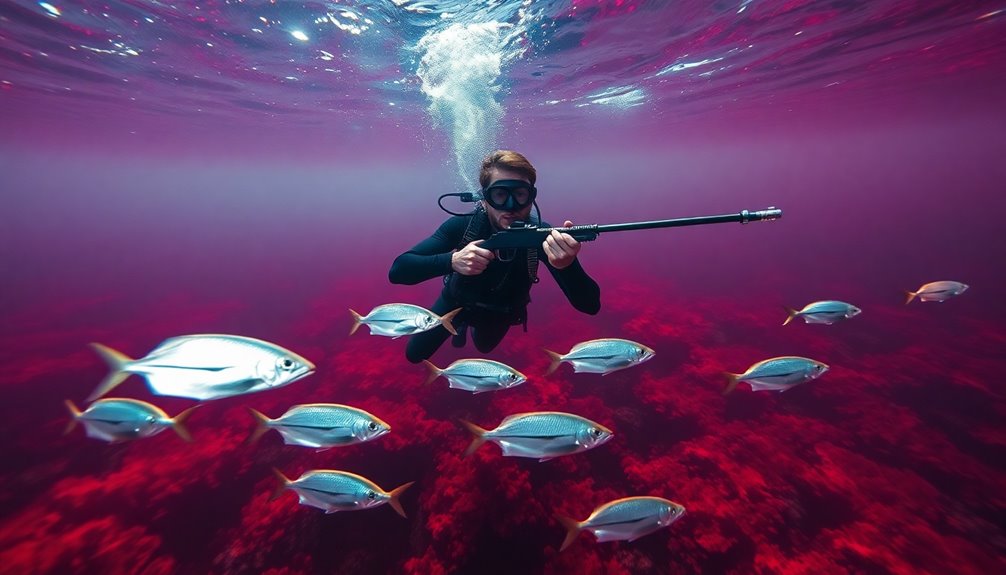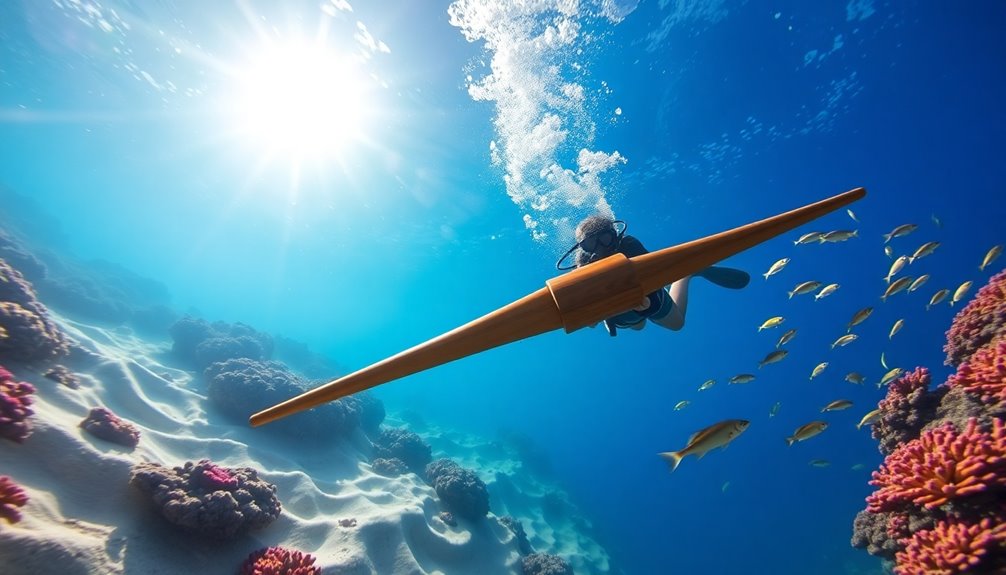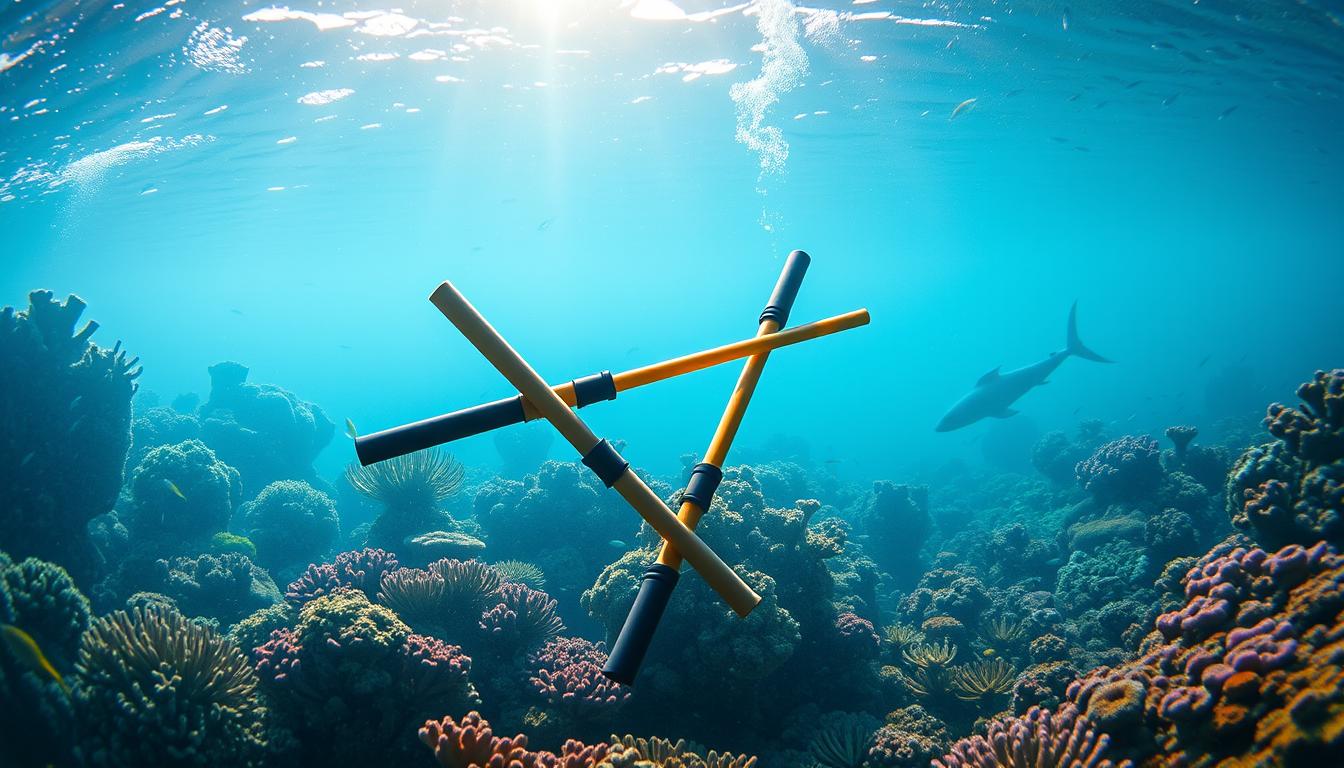Spearfishing is not just a sport; it’s a way of life for enthusiasts who are passionate about underwater exploration and the thrill of the hunt. Whether you are an experienced spearfisherman or a beginner looking to embark on a new adventure, there are incredible spearfishing spots waiting for you near your location. Let’s dive in and discover the best destinations for your next spearfishing expedition.
Key Takeaways:
- Traveling worldwide to explore the best spearfishing spots is a testament to the dedication and interest within the spearfishing community.
- Hawaii offers a diverse range of species for spearfishing, including Bluespotted Grouper, Blacktail Snapper, Giant Trevally, Mahi Mahi, Wahoo, Yellowfin, and Bigeye Tuna.
- The Azores have become a popular spearfishing destination following Paulo Alfonso’s record-breaking catch of a 240 lb Bigeye Tuna, attracting spearos from around the world.
- San Diego boasts a thriving fishery with a variety of species suitable for spearfishing, such as Sheepshead, Calico Bass, Spiny Lobster, Pacific Halibut, White Seabass, Yellowtail Amberjack, Yellowfin Tuna, Bluefin Tuna, and Sharks.
- Krabi in Thailand provides excellent spearfishing opportunities in shallow waters, making it an ideal destination for beginners, with catches including Groupers, Mangrove Jacks, Golden Snapper, Kings, Mahi, Queens, and Cudas.
Hawaii – A Spearfishing Paradise
Hawaii, with its crystal clear waters and abundant marine life, is a spearfishing paradise. Spearfishing destinations don’t get much better than the islands of Hawaii. With over 130 islands providing ample opportunities for spearing, both in bluewater spots and nearshore locations, there is no shortage of incredible spearfishing locations to explore.
Whether you’re a beginner or an experienced spearo, Hawaii offers something for everyone. Beginners can learn the art of spearfishing using the traditional Hawaiian sling, a simple and effective tool. Anini Beach in Kauai is often highlighted as a suitable spot for beginner spearos due to its calm waters and easy access.
For more experienced divers, the Kailua-Kona area on the Big Island is known as the most prolific spearfishing region in Hawaii. Here, you can venture offshore to target Mahi Mahi, Wahoo, Yellowfin Tuna, and Bigeye Tuna. The Yellowfin Tuna season peaks during the summer, with these powerful fish reaching up to 300 pounds, providing an exhilarating challenge for spearos.
But it’s not just big game fish that attract spearfishers to Hawaii. The colorful reefs surrounding the islands are teeming with a variety of species, including Bluefin Trevally, Amberjack, Snappers, and many more. The underwater diversity in Hawaiian waters is truly remarkable.
One exceptional site for spearfishing in Hawaii is Maui’s Molokini Crater. This volcanic cone, located just off the coast of Maui, offers an abundance of marine life and pristine waters, making it a must-visit spot for any spearo. With visibility reaching up to 100 feet on a clear day, the Molokini Crater is a dream for underwater hunters.
It’s important to note that spearfishing in Hawaii emphasizes the principles of selective fishing to protect the delicate balance of the marine ecosystem. Spearfishers adhere to local regulations on size and bag limits to ensure sustainable fishing practices. Conservation efforts are an integral part of the spearfishing community in Hawaii, with spearfishers actively engaging in activities such as beach clean-ups, marine life awareness campaigns, and educational workshops.
Lancaster Scuba is your go-to source for all your spearfishing needs in Hawaii. They provide top-quality scuba gear, expert diving instruction, and PADI certification courses, including specialized courses for spearfishing. So whether you’re a seasoned spearo or just starting out, get ready to embark on an unforgettable spearfishing adventure in the captivating waters of Hawaii!
The Azores – A World-Class Spearfishing Destination
The Azores, a group of nine volcanic islands located in the middle of the North Atlantic Ocean, has quickly gained recognition as a world-class spearfishing hotspot. Enthusiastic spearos from around the globe flock to the Azores to experience its abundant marine life and unmatched fishing opportunities.
One of the highlights of spearfishing in the Azores is the chance to target various tuna species, including the prized Giant Bluefin, Yellowfin, and Albacore Tuna. Local guides, with their extensive knowledge of the area, take spearos to narrow seamounts known as pinnacles, where these magnificent Tunas and other fish species congregate.
In addition to the thrilling Tuna fishing, the Azores offers a diverse range of spearfishing sites. Princess Alice Bank, located 50 miles offshore, is a wild spot renowned for its challenging conditions and the opportunity to catch big game fish. Its 30-meter pinnacle attracts seasoned spearos seeking the ultimate adrenaline rush. Some other notable sites for spearfishing include Condor Bank, known for its variety of fish species, and designated Marine Protected Areas (MPAs) like Grouper Bay, which ensure the preservation of marine biodiversity.
To ensure the sustainable pursuit of spearfishing, the Azores has implemented specific regulations such as limits on daily catches. Each recreational spearfisher is restricted to capturing a maximum of 10 fish and octopus per day, along with two crustaceans. Similarly, minimum legal size regulations are in place for various species, such as Red Seabream (18 cm), European Conger (133 cm or 5 kg), and Blackspot Seabream (30 cm or 400 g).
To engage in spearfishing in the Azores, obtaining the necessary licenses is crucial. Spearfishing licenses are available for different durations, including three years (€75), one year (€25), monthly (€10), and daily (€5) options. These licenses can be acquired through various entities such as the RIAC Office, Regional Fisheries Directorate, and Nautical Associations or Sailing Clubs.
For avid spearos seeking the ultimate Azores spearfishing experience, specialized trips and packages are available. From guided shore dives (€150) to more advanced options like blue water spearfishing (€1000) and remote expeditions to spots like Princess Alice pinnacle (€1400), there are choices to cater to every level of experience and preference. These packages often include inshore spearfishing, reef dives, and offshore pinnacles, ensuring an unforgettable adventure for enthusiasts.
Accommodation and Beyond
When visiting the Azores for spearfishing, adventurers have a wide range of accommodation options to suit their preferences. From camping in nature to 5-star hotels, there is something for everyone. This ensures that visitors can find comfortable places to stay while enjoying all the thrilling experiences the Azores has to offer.
Moreover, the Azores is not only a paradise for spearfishers but also a family-friendly destination. Beyond spearfishing, families can engage in activities such as whale watching, scuba diving, hiking, mountain climbing, and exploring natural lagoons. This diverse range of options makes the Azores an attractive choice for families looking to create lasting memories together.
So, what are you waiting for? Grab your spearfishing gear, book your trip to the Azores, and get ready for an unforgettable adventure in one of the world’s most captivating spearfishing destinations.

San Diego – A Diverse Spearfishing Playground
San Diego, known as “America’s Finest City,” offers a diverse range of spearfishing locations that will satisfy both beginners and experienced spearos. Whether you’re exploring the inshore reefs or venturing further offshore, San Diego provides abundant opportunities to test your skills and reel in some impressive catches.
For beginners, the inshore areas, such as Mission Bay Jetty, offer a great starting point. Here, you can target species like Sheepshead, Calico Bass, and Spiny Lobster as you familiarize yourself with the sport.
But it’s the offshore waters near Point Loma that truly make San Diego a spearfishing paradise. Within a day’s voyage, you’ll find teeming schools of bluefin tuna, yellowfin tuna, yellowtail, and dorado. The Cortez Bank, approximately 100 miles west of Point Loma, is especially renowned for its nutrient-rich waters, attracting massive schools of bluefin tuna, yellowfin tuna, and dorado.
Another prime spot is San Clemente Island, located over 60 miles offshore from San Diego. This island is abundant with bluefin tuna, dorado, and yellowtail, thanks to strong upwellings and nutrient flows that support a thriving ecosystem.
Yellowtail enthusiasts will find their hotspots in the 9-Mile Bank, Coronado Islands, 182-spot, and Hidden Bank. These areas offer distinct characteristics for yellowtail fishing, influenced by sea surface temperatures and bait availability. And if you’re targeting yellowfin tuna, strategic areas such as the 9-Mile Bank, 181 Spot, Coronado Islands, and Tanner and Cortez Banks are known for their bigger grade yellowfin.
When it comes to dorado fishing, keep an eye on warm currents during the summer and fall months. Areas like the Tanner and Cortez Banks and Condom Bank often attract migrating dorado, with warm currents supporting their presence. Look out for frigate birds, as their sightings indicate feeding dorado, and floating kelp paddies can be great spots to find these beautiful fish.
Aside from the abundance of offshore fishing opportunities, San Diego also offers a range of inshore species. San Diego Bay, stretching over 12 miles, is home to California Halibut, a prized catch weighing between 4 and 10 pounds, with larger specimens reaching up to a whopping 40 pounds. And don’t forget about the rockfish! San Diego’s waters are abundant with Starry and Vermillion Rockfish, with different seasons providing prime fishing opportunities.

The Pacific Halibut, found in San Diego Bay, can reach impressive sizes.
Whether you prefer the thrill of offshore big game fishing or the challenge of inshore species, San Diego’s diverse spearfishing playground has it all. With its stunning coastal landscape, iconic attractions, and a wide range of fishing methods to choose from, San Diego truly stands out as one of the best fisheries on the West Coast. So, grab your spear and get ready to dive into an unforgettable spearfishing adventure in San Diego!
| Spearfishing Locations in San Diego | Main Species |
|---|---|
| Mission Bay Jetty | Sheepshead, Calico Bass, Spiny Lobster |
| Offshore Waters near Point Loma | Bluefin Tuna, Yellowfin Tuna, Yellowtail, Dorado |
| Cortez Bank | Bluefin Tuna, Yellowfin Tuna, Dorado |
| San Clemente Island | Bluefin Tuna, Dorado, Yellowtail |
| 9-Mile Bank, Coronado Islands, 182-spot, Hidden Bank | Yellowtail |
| Tanner and Cortez Banks | Dorado, Bluefin Tuna |
| San Diego Bay | California Halibut |
Krabi – Underwater Beauty in Thailand
Krabi, located in Thailand, is a true gem for spearfishing enthusiasts. This tropical paradise offers not only breathtaking natural beauty but also abundant spearfishing opportunities. With its crystal-clear turquoise waters and diverse marine life, Krabi is a dream destination for underwater adventurers.
When it comes to spearfishing, Krabi has it all. Whether you’re a beginner or an experienced spearo, there are dive sites to suit every skill level. The Ao Nang area alone boasts around 10-15 dive schools, where you can receive expert guidance and hone your spearfishing skills.
Exploring the waters around Krabi, you’ll have access to approximately 20 dive sites. These sites offer a depth range of 0-18 meters, with some sites reaching depths of 25-30 meters. The visibility underwater is excellent, averaging 10-20 meters, allowing you to fully admire the vibrant marine life and stunning coral reefs.
The water temperature in the Krabi area remains a pleasant 27-30°C (80-85°F), providing optimal conditions for spearfishing adventures throughout the year. The best time to visit Krabi for diving is from October to May, when the weather is consistently favorable.
What sets Krabi apart is its rich variety of marine life. As you explore the underwater world, you may encounter blacktip reef sharks, hawksbill sea turtles, giant moray eels, soft corals, big schools of fusiliers, and even leopard sharks. Each dive promises an awe-inspiring encounter with these magnificent creatures.
To fully experience the glory of Krabi’s underwater realm, diving expeditions often require a short journey of 2-2.5 hours from Ao Nang to the dive sites. This journey time allows you to soak up the beauty of the surroundings as you anticipate the incredible spearfishing opportunities ahead.
| Number of Dive Schools | 20 |
|---|---|
| Number of Dive Sites | 0-18 meters, up to 25-30 meters at select sites |
| Visibility | Good, averaging 10-20 meters |
| Water Temperature Range | 27-30°C (80-85°F) |
| Best Time to Dive | October to May |
| Marine Life | Blacktip reef sharks, hawksbill sea turtles, giant moray eels, soft corals, big schools of fusiliers, leopard sharks |
| Typical Dive Boat Capacity | 30-50 divers |
| Travel Time to Dive Sites | 2-2.5 hours |
Discovering Krabi Beyond Spearfishing
While spearfishing is the main attraction in Krabi, the destination offers much more to explore. You can take a break from the underwater adventures and visit the stunning Koh Phi Phi, just a short 2.5-hour boat ride away from Ao Nang. Alternatively, opt for a thrilling 45-minute speedboat ride to reach Koh Phi Phi. The island’s beauty is not to be missed.
If you’re looking for a truly immersive experience, consider embarking on a tour of the Surin Islands. This expedition spans three days and two nights, giving you ample time to explore Koh Surin National Park’s snorkeling spots, including the famous Mae Yai Bay. Here, you can indulge in snorkeling excursions, visit the Moken village, and engage in cultural education sessions.
During your stay on Koh Surin, it’s important to note that electricity is available from 18:00 to 06:00 the following morning. This limited supply adds to the island’s charm and emphasizes the need for sustainable tourism practices to preserve the environment and the Moken community, with the help of organizations like Andaman Discoveries.
Andaman Discoveries is recognized for its commitment to supporting the Moken community over the past 20 years. After a fire incident in 2014, Andaman Discoveries played a vital role in rebuilding the Moken village, contributing to the preservation of their culture and heritage.
So, whether you’re seeking spearfishing adventures or an immersive cultural experience, Krabi in Thailand has it all. Discover the underwater beauty, encounter mesmerizing marine life, and create unforgettable memories in this tropical haven.

Image: A spearfisherman diving in the turquoise waters of Krabi, Thailand.
Cozumel – A Colorful Spearfishing Paradise
Located in the middle of the Mesoamerican Barrier Reef, Cozumel stands as one of the world’s top five dive sites and offers exceptional spearfishing opportunities. This vibrant island, renowned for its crystal-clear waters and diverse marine ecosystem, attracts spearos from all over the globe.
Cozumel’s abundant spearfishing spots provide an exhilarating experience for both beginners and experienced spearos. The waters surrounding the island teem with an array of fascinating underwater creatures. From the majestic Triggerfish to the elusive Snapper, Grouper, and Lionfish, every dive promises excitement and adventure.
Cozumel’s location on the Mesoamerican Barrier Reef offers access to thrilling species such as Barracuda, Wahoo, and Mahi Mahi. Spearos can test their skills against some of the most prized catches in these beautiful azure waters.
But Cozumel is not only a paradise for spearfishing; it is also a treasure in itself. With its pristine beaches, warm hospitality, and awe-inspiring marine life, Cozumel invites you to embark on a unique spearo’s journey.
While spearfishing, take the opportunity to explore beyond the underwater realm. Visit the Punta Sur Beach Eco Park, where you can discover the island’s natural beauty and observe exotic bird species. Or delve into the island’s rich history by exploring the nearby Mayan ruins.
At the end of the day, indulge in a delicious feast of your catch, as Spearfishing Today, one of the leading spearfishing charters in Cozumel, follows the sustainability concept of ‘From Sea to Table.’ By promoting responsible fishing practices, they ensure the preservation of the region’s marine resources.
Spearfishing Today – The Ultimate Guide to Cozumel Spearfishing
“Spearfishing Today is more than just a charter company; it’s a community passionate about spearfishing,” says a satisfied customer. With their establishment in 2008, Spearfishing Today has grown from a one-person operation to a thriving business that caters to both beginners and experienced spearos.
With a strong focus on customer satisfaction, Spearfishing Today has received an impressive 490 reviews, with the majority being positive. Their experienced guides ensure that every trip is not only adventurous but also safe and informative.
If you want to get a glimpse into the thrilling world of spearfishing, Spearfishing Today’s Instagram page offers a collection of diverse posts showcasing amazing spearfishing adventures and experiences. Follow them to stay up-to-date and get inspired for your next underwater excursion.
| Charter Type | Price (USD) | Group Size | Inclusions |
|---|---|---|---|
| Beginners’ Spearfishing Charters | $297 and up | 1-10 people | Fishing equipment, snacks, and refreshments |
| Experienced Spearos Charters | $417 and up | 1-10 people | Fishing equipment, snacks, and refreshments |
| Luxury Charters | $1177 and up | 1-10 people | Fishing equipment, snacks, refreshments, and additional amenities |
Spearfishing Today offers a range of fishing charters tailored to different group sizes and expertise levels. Whether you’re a beginner or a seasoned spearo, there’s a charter that will cater to your needs. With prices starting from $297 USD, you can embark on a memorable spearfishing adventure without breaking the bank.
Engage in an unforgettable fishing experience in Cozumel, creating lasting memories and reaping the rewards of your skills. Book a charter with Spearfishing Today and explore the colorful depths of Cozumel’s mesmerizing underwater world.

Key West – The Home of Big Fish
Key West, located in the southernmost point of the United States, is a paradise for spearfishing enthusiasts. Known for its vibrant underwater world and abundant fish species, Key West offers a thrilling experience for both beginners and experienced spearos.
One of the top targets for spearfishers in Key West is the Hogfish. These prized fish can be found in depths ranging from 10 feet to over 100 feet deep, inhabiting various environments such as grass beds, reefs, and sand. Their delicious taste and challenging nature make them a favorite among spearos.
Another popular catch in Key West is the Mutton Snapper. These fish come into shallow waters to spawn beginning around the full moon in June, making the Summer months the best time to target them. Their large size and strong fight make them a thrilling challenge for spearfishers.

For those looking for fast-moving targets, Cero Mackerel are an excellent option. These fish can be found in the water column, moving quickly and making them an exciting challenge for spearfishers. They are also shallower than King Mackerel, making them more accessible to divers.
The waters around Key West are also home to Yellow Jacks, which are commonly found swimming near structures such as bridges, wrecks, and rocky bottoms throughout the Florida Keys. Their powerful fight and delicious meat make them a sought-after target for spearos.
While exploring the reefs and wrecks in Key West, spearfishers may come across Lionfish. However, caution must be exercised when handling them, as they have venomous barbs along their back. Lionfish are an invasive species in the Florida Keys, and capturing them is an important part of conservation efforts.
When it comes to the pinnacle of spearfishing in Key West, Black Grouper takes the spotlight. These world-class eating fish can be found hiding in the reef, providing a challenging yet rewarding catch for spearos. Their firm white meat is highly prized and is a staple on many local menus.
Red Grouper are another prized menu item in the Florida Keys. They respond well to chumming before diving and are commonly found near ledges and structures. Spearfishers can enjoy the thrill of the chase while targeting these delicious fish.
Barracuda, although not commonly found on menus, are known for their good taste and provide an exhilarating experience for spearfishers. Smaller Barracuda pose little risk of the rare Ciguatera disease, making them a suitable option for those looking to diversify their catch.
In addition to these exciting species, Gray Triggerfish can be found in abundance in the Atlantic and are a local favorite for their delicious firm white meat. These fish are a must-try for spearos visiting Key West.
| Hogfish | Mutton Snapper | Cero Mackerel | Yellow Jacks | Lionfish |
|---|---|---|---|---|
| Can be found in depths ranging from 10 ft to over 100 ft deep. | Come into shallow waters to spawn around the full moon in June. | Shallower than King Mackerel and move quickly in the water column. | Commonly found swimming near structures such as bridges, wrecks, and rocky bottoms. | An invasive species with venomous barbs along their back. |
| Black Grouper | Red Grouper | Barracuda | Gray Triggerfish |
|---|---|---|---|
| Can be found hiding in the reef and are considered the pinnacle of spearfishing in Key West. | Respond well to chumming before diving and are commonly found near ledges and structures. | Known for their good taste and smaller Barracuda pose little risk of Ciguatera disease. | Plentiful in the Atlantic and a local favorite for their delicious firm white meat. |
Spearfishing classes and guided excursions are available in Key West, ranging from around $140 to $850. These activities offer valuable training and local knowledge to ensure a safe and successful spearfishing experience.
Whether you’re a beginner or an experienced spearo, Key West has something to offer. From the Middle Keys, with fewer restrictions and more shipwrecks, to the southernmost point of the US, where beginners can hunt for Hogfish and smaller Snappers in multiple coral heads, there are ample opportunities to immerse yourself in the exciting world of spearfishing.
In Marathon, FL, several wrecks and islands further from the coast provide sought-after species like larger Groupers and Snappers, making it a must-visit destination for spearos.
Experienced spearfishers can also explore the offshore areas in the Florida Keys, which provide deeper and faster water conditions. Here, they can target a variety of fish such as Mahi Mahi, Tuna, and Wahoo, making for an exhilarating and diverse spearfishing experience.
The Florida Keys are renowned as one of the top spearfishing locations in the world. With its abundant fish species, suitable underwater conditions, and breathtaking natural beauty, it’s no wonder that spearfishing remains a popular tourist activity in the Florida Keys, attracting water sports enthusiasts and fishermen to its rich seas.
North California – A Haven for Ling Cod
North California boasts some of the best spearfishing opportunities in the region. With its rich marine biodiversity and diverse underwater landscapes, this area is a paradise for underwater hunters. One of the prized catches in North California is the Ling Cod, a powerful and elusive fish that attracts spearos from all over.
The waters near North California provide excellent visibility, often exceeding 30 feet on a good day. This clarity allows spearfishers to navigate the reefs and spot their targets with precision. Whether you are a seasoned hunter or a beginner, spearfishing in North California offers a thrilling and rewarding experience.
The Ling Cod, known for its aggressive nature and impressive size, is a popular target for spearos in North California. These fish can grow up to 56 pounds, providing a challenge for even the most skilled hunters. Ling Cod are found hiding in crevices and holes along rocky reefs, testing your hunting skills and patience. With their delicious white meat, Ling Cod make a fantastic meal for those lucky enough to catch them.

Top Spearfishing Spots in North California
When it comes to spearfishing in North California, there are some standout locations that offer excellent opportunities to encounter Ling Cod and other exciting species. Here are a few notable spots:
| Spearfishing Spot | Noteworthy Species | Conditions |
|---|---|---|
| Mendocino County | Ling Cod, Rockfish, Halibut | Good visibility, diverse marine life |
| Fort Bragg | Ling Cod, Rockfish, Salmon | Clear waters, rocky reefs |
| Point Arena | Ling Cod, Rockfish, Halibut | Challenging conditions, strong currents |
Each of these locations offers unique spearfishing experiences, allowing you to explore the stunning underwater world of North California and encounter magnificent marine creatures.
As with any spearfishing activity, it’s essential to prioritize conservation and adhere to size and bag limits to protect the marine environment. Responsible fishing practices ensure that future generations can continue to enjoy the abundant marine life that North California has to offer.
Whether you are a local spearo or a visitor looking for an exciting adventure, North California is the perfect destination to immerse yourself in the world of spearfishing and set your sights on the prized Ling Cod.
Southern California – Yellowtail Paradise
Southern California is a spearfishing paradise, offering a diverse range of fishing opportunities in its warm waters. One of the most sought-after targets for spearos in the region is the Yellowtail. Native to Southern California, the Yellowtail Amberjack is known for its powerful fighting ability and delicious taste.
Popular spearfishing locations in Southern California include Catalina Island, La Jolla Cove, and the Channel Islands. Catalina Island, situated just 22 miles off the coast, is a premier destination for spearfishing enthusiasts. With over 50 miles of stunning coastline and unique underwater topography consisting of rocky reefs, kelp forests, and sandy bottoms, Catalina Island offers a diverse range of habitats attracting various fish species.
The Channel Islands National Marine Sanctuary, which surrounds Catalina Island, protects the marine ecosystems and ensures the preservation of its abundant marine biodiversity. Marine life on Catalina Island includes not only Yellowtail but also calico bass, white seabass, halibut, and many other species that provide exciting spearfishing opportunities.
Top 5 spearfishing spots on Catalina Island:
| Spearfishing Spot | Description |
|---|---|
| Ship Rock | A popular spot known for its abundance of Yellowtail and other pelagic species. |
| Farnsworth Bank | Offers diverse marine life, including Yellowtail, rockfish, and even the occasional tuna. |
| Blue Cavern Point | A unique dive site characterized by its large caverns and presence of kelp forests, where Yellowtail can often be found. |
| Casino Point Dive Park | A designated dive park in Avalon, providing opportunities for beginners to explore and target various fish species. |
| Italian Gardens | Known for its clear visibility and rocky terrain, this spot is home to a variety of fish species, including Yellowtail. |
When spearfishing in Southern California waters, it’s important to abide by the regulations in place to protect the environment and ensure sustainable fishing practices. California spearfishing regulations include restrictions on species, size limits, bag limits, and specific fishing areas. It’s crucial to stay informed and adhere to these guidelines.
Whether you’re a seasoned spearfisher or just starting out, Southern California offers an abundance of spearfishing opportunities. With its warm waters, better visibility, and a variety of fish species including Yellowtail and White Sea Bass, Southern California is a must-visit destination for any spearfishing enthusiast.

References:
- Popular spearfishing locations in Southern California include Catalina Island, La Jolla Cove, and the Channel Islands
- Southern California offers warm waters and better visibility for spearfishing compared to Northern California
- Yellowtail Amberjack is a highly sought-after spearfishing target in Southern California
- California spearfishing regulations include restrictions on species, size limits, bag limits, and specific fishing areas
- Getmyboat is the #1 app for boat rentals and charters, offering over 150,000 boats ready to rent and charter in top boating destinations.
Block Island – Chasing Striped Bass

Located just nine miles from the mainland of Rhode Island, Block Island is a paradise for spearos looking to chase the elusive Striped Bass. The waters surrounding Block Island offer a diverse range of fish species, making it an ideal destination for spearfishing enthusiasts. However, the real highlight of Block Island is the opportunity to hunt down the renowned Striped Bass.
The best time to spearfish for Striped Bass in Rhode Island waters is from June to October, with July being particularly productive. These predatory fish are often found hunting in shallower waters near the rocky coastline, making them accessible to spearos of all skill levels. To attract Striped Bass, it is recommended to use bait fish around 3″ in length, as they tend to be more effective compared to smaller bait fish.
When planning a spearfishing trip to Block Island, it is crucial to consider various factors that can impact your success. The range of depths for spearfishing Striped Bass in the area is typically between 6′ to 15′. Additionally, optimal visibility is key for a successful dive. In Rhode Island waters, a visibility of around 4′ is recommended for spearfishing. It is important to note that heavy rainfall in the last 2 days can negatively impact water visibility, so plan your dives accordingly.
Wave height is another crucial factor to consider. Waiting at least 2 days after waves reach over 3′ is advisable to ensure optimal diving conditions. Furthermore, the tide plays a significant role in visibility. Starting a 3-hour dive session approximately 2 hours before high tide is recommended for better visibility.
To make the most out of your spearfishing adventure in Block Island, it is worth noting that visibility tends to be better during sunrise and sunset. These times of the day offer better lighting conditions and increased chances of spotting Striped Bass.
While Striped Bass is the star of the show in Block Island, the area also offers opportunities to catch other fish species, including Winter Flounder and Blackfish. So, whether you’re targeting Striped Bass or looking to diversify your catch, Block Island has something to offer for every spearfishing enthusiast.
Florida – Abundance of Fish Species
Florida, with its picturesque coastline and warm waters, is a haven for spearfishing enthusiasts. The state offers numerous prime locations for both beginner and experienced spearos to embark on exciting underwater adventures. Coastal areas such as Miami, the Florida Keys, and West Palm Beach boast diverse marine ecosystems, attracting a wide array of fish species.
One of the most enticing aspects of spearfishing in Florida is the abundance of fish species that can be targeted. From Spanish mackerel to black grouper, mahi-mahi, and lionfish, spearos have a variety of exciting targets to set their sights on. The state’s warm waters support a thriving ecosystem, making it an ideal destination for spearfishing.
However, it’s important to note that fish availability in Florida can be influenced by seasonal variations, migration patterns, and regulations. To ensure sustainable fishing practices, spearos must adhere to specific regulations governing size limits, bag limits, and protected species. Protecting Florida’s marine ecosystem is crucial for the preservation of its diverse fish populations.
To engage in spearfishing in Florida, enthusiasts must obtain a saltwater fishing license with an additional spearfishing endorsement. This requirement applies to both residents and non-residents, ensuring that everyone adheres to the state’s regulations and contributes to responsible fishing practices.
When participating in spearfishing activities, safety should always be a top priority. Never dive alone and always dive within your limits, staying within your comfort zone. It is also essential to practice proper breath-holding techniques to ensure a safe and enjoyable experience.
Conservation practices play a vital role in spearfishing. As a responsible spearo, it is important to avoid overfishing and respect protected areas to help preserve the marine ecosystems that make spearfishing in Florida so extraordinary.
Diverse Spearfishing Destinations in Florida
Florida offers a range of diverse spearfishing destinations, each with its own unique characteristics that attract water sports enthusiasts and spearos alike.
| Destination | Reef Structures | Fish Species |
|---|---|---|
| South Walton, Walton County | Over 700 reef structures across 16 sites | Snapper, cobia, king mackerel |
| Jacksonville | Over 100 artificial reefs | Snapper, grouper, hogfish, cobia |
| Tampa | Egmont Key, Skyway Bridge | Snapper, grouper, hogfish, cobia |
| Titusville | Indian River Lagoon, Sebastian Inlet State Park | Snook, redfish, sheepshead |
| South Florida | Clear waters attracting water sports enthusiasts | Spearfishing paradise |
These destinations offer a wide range of depths and diverse fish populations, ensuring that spearos of all levels can enjoy memorable experiences. Whether you’re searching for Snapper, Cobia, or the thrilling challenge of hunting Sailfish, Florida’s stunning coastline has something to offer every spearfishing enthusiast.

In conclusion, Florida is a spearfishing paradise, providing ample opportunities to explore its diverse marine ecosystems and encounter a wide variety of fish species. It’s crucial to practice responsible fishing, adhere to regulations, and prioritize marine conservation to ensure the sustainability of Florida’s underwater treasures. So grab your gear, obtain your fishing license, and embark on an exhilarating spearfishing adventure in the beautiful waters of Florida.
Conclusion
Spearfishing offers a thrilling and immersive underwater adventure, allowing you to explore the depths while hunting for your own catch. Throughout this article, we have delved into the top spearfishing spots around the world, including Hawaii, the Azores, San Diego, Krabi, Cozumel, Key West, North and Southern California, Block Island, and Florida.
These locations showcase a diverse range of fish species, each offering its own unique underwater landscape and fishing opportunities. Whether you are a beginner or an experienced spearo, there is a top spearfishing spot that caters to your skill level and preferences.
As you embark on your spearfishing journey, remember to research and plan your dives, observe marine life and behavior, utilize technology when necessary, and prioritize environmental considerations. Safety should always be a priority, so dive with a buddy and keep a dive log to record your experiences and track your progress.
So gear up, dive into the underwater world, and create unforgettable memories in some of the world’s most remarkable spearfishing destinations. Whether you’re exploring the vibrant reefs of Hawaii or chasing Striped Bass off the coast of New York, your spearfishing adventure awaits! Don’t forget to hone your skills and practice proper techniques, as each location offers unique challenges and opportunities. For those heading to Australia, mastering spearfishing blue groper techniques is essential, as this iconic species requires patience and precision. With the right approach, you’re sure to have a rewarding experience and bring home stories of both triumph and respect for the underwater world.

